
침입 해충인 등검은말벌 (Vespa velutina nigrithorax)의 가을철 생식세대 활동과 봉군 온도 조절 연구
Abstract
The nest of the Vespa velutina nigrithorax rapidly grow from spring to autumn and decline in late autumn following the production of the reproductive generation. The timing and the process of the reproductive generation by new queens and drones and its nest temperature regulation are poorly studied. We collected the nests of V. velutina and housed under the rain-shed facility in early autumn and observed the production of reproductive generation and nest temperature. The internal temperature of the nest remained relatively constant around 25°C and then dropped to the ambient temperature after the production of the reproductive generation. The peak emergence of the reproductive generation was observed in mid-October. Flight activity of the reproductive generation began at 10:00 and showed highest at 13:00 under the clean sky. The flight activity showed positive correlations with light intensity and temperature. Understanding the reproductive period could help managing the overwintering next generation of this important, invaded honeybee predator.
Keywords:
Circadian rhythm, Copulation, Thermos-regulation, Social insects, Invasion서 론
등검은말벌 (Vespa velutina nigrithorax Buysson, 1905)은 말벌과 말벌속에 속하며 중국 남부, 인도네시아 등 동남아시아에 걸쳐 분포하는 11개의 아종 집단을 가진 곤충 중 (Abrol, 1994), 중국 남부지역에서 우리나라로 침입한 생물집단이다 (Jung et al., 2008; Choi, 2012; Takeuchi et al., 2017). 이 아종 집단은 2004년 프랑스로도 침입이 일어났으며, 그 후 스페인, 독일 등 유럽 대부분의 국가로 확산이 이루어지면서 위해성이 증가하고 있다 (Rortais et al., 2010; Roy et al., 2011). 2003년 부산 봉래산에서 최초 보고된 국내 집단 역시 한반도에서 정착하면서 (Kim et al., 2006) 전국적으로 분포가 확산되었을 뿐 아니라, 우점도가 높아 토착 말벌 군집에 큰 영향을 주고 있다 (Jung, 2012; Kim et al., 2023). 2014년에는 대마도를 거쳐 일본으로의 침입도 이루어졌다 (Ueno, 2014). 등검은말벌의 주 포식 대상은 꿀벌이기에 양봉장에서 많은 피해가 보고되었다 (Jung et al., 2008, 2012; Monceau et al., 2014; Jeong et al., 2016). 뿐만 아니라, 나비, 파리 등 다양한 화분매개자를 포함한 곤충을 먹이로 하기 때문에 생태계 서비스와 생물다양성에도 영향이 보고되었다 (Rome et al., 2021).
등검은말벌을 비롯한 말벌속 곤충은 진사회성으로 한 마리의 여왕벌과 여러 마리의 일벌이 모여 거대한 집단을 형성한다 (Jung et al., 2008; O’Donnell, 1998). 봄철 여왕벌에 의해 시작되는 말벌 집단은 1년생 생활사를 지녔기에, 가을철 생식세대를 생산하고, 신여왕벌은 짝짓기를 마친 후 동면에 든다 (Matsuura and Yamane, 1990). 주로 썩은 나무와 흙 속에서 동면하며 (Van Itterbeeck et al., 2021), 봄에 기온이 상승하면 동면에서 깨어나 월동처 근처에서 수액, 꽃 꿀 등, 탄수화물을 섭취한다. 이후 홀로 호리병 모양 외벽을 가진 1차 둥지를 짓는다 (Abrol, 1994). 내부에는 10개 전후의 방이 존재하며 여왕벌이 직접 사냥 및 육아를 담당한다 (Jung, 2012). 첫 배 일벌이 우화하는 데는 약 20~30여 일이 필요하며, 이후 여왕벌은 산란에 집중하고 먹이사냥과 육아 등은 일벌들이 맡게 되며, 집단이 커지면서 기존 둥지를 버리고 더 큰 새로운 둥지를 건설한다. 말벌은 유충의 먹이로 다양한 먹이를 사냥하지만, 꿀벌을 선호하기 때문에 (Cini et al., 2018; Rome et al., 2021), 등검은말벌, 장수말벌 등 일부 종은 양봉장에서 큰 피해를 초래한다 (Jeong et al., 2016).
말벌 둥지의 외벽은 내부 봉판을 구형으로 감싸는 형태로 여러 개의 거품이 중첩된 모양으로 만들어진다 (Takahashi et al., 2002). 증축 재료는 주로 침엽수, 활엽수 등의 목본 식물이 주를 이루며, 초본도 일부 포함된다 (Crespo et al., 2022). 내부에는 유충이 자라는 방이 여러 개 모여 한 층을 이루고 밑으로 한 층씩 확장해 간다 (Villemant et al., 2008). 내부 환경 조건은 일벌들의 날갯짓에 의한 발열, 환기 등으로 일정하게 유지된다. 온도 유지는 유충 생육발달에 중요한 영향을 미친다 (Feás Sanchez and Charles, 2019). 구조상 외부와 구분되어 있어 강우를 막아줄 뿐 아니라 내부의 온도를 일정하게 유지하는 데 도움을 준다 (Feás Sanchez, 2021). 등검은말벌은 높은 나무 꼭대기에 둥지를 짓는 경우가 많으나, 간혹 도심지나 지붕 처마에 짓기도 한다 (Jung, 2012; Jung et al., 2014).
등검은말벌은 주행성 곤충으로 증축 재료 채집, 사냥 등 대부분의 활동은 낮에 이루어진다 (Monceau et al., 2017). 활동 강도는 강우, 기온 등 기상 상황 등에 따라 달라진다 (Abrol, 1994). 이는 말벌속의 공통적인 특징이나 토착 말벌류와 달리 등검은말벌은 비교적 이른 시간인 오전 5시에 활동을 시작한다. 오전 9시~오후 1시가량이 활동이 활동 최성기로 기록되었으며, 오후 9시 이후까지 긴 활동 시간을 보인다 (Perrard et al., 2009). 활동은 여름부터 급격히 증가해 8~9월 사이에 최성기를 이루고 12월까지 지속적으로 수벌과 신여왕벌을 생산해 방출하며 둥지는 쇠퇴하기 시작한다 (Jung et al., 2008).
등검은말벌의 짝짓기 시기는 토착 말벌류와 같이 가을철로 확인되었으나 (Choi et al., 2012), 정확한 시기는 특정되지 않았다. 근친교배를 방지하기 위해 수벌과 여왕벌은 둥지를 떠나 짝짓기를 한다 (Monceau et al., 2013). 등검은말벌의 수벌은 공기의 흐름이 원활한 나무 꼭대기에 수컷집합구역 (Male congregation area, MCA)을 형성해 페로몬을 추적한다 (Wen et al., 2017; Cheng et al., 2022). 수컷의 짝짓기 시도는 광량과 기온이 높고, 습도, 풍속 등이 낮은 환경에서 자주 발생한다고 보고되었다 (Cheng et al., 2022). 여러 마리의 수벌과 짝짓기를 하는 경우도 있으나 (Takahashi et al., 2004), 대부분은 한 마리의 수벌과 짝짓기를 하는 것으로 알려졌다 (Takahashi et al., 2002, 2004, 2007).
국내에서 생식세대 말벌의 활동 시기, 봉군 내부 환경 조절에 대한 국내 자료는 빈약하다. 본 연구에서는 등검은말벌의 가을철 생식세대의 활동 기간과 활동에 미치는 요인을 분석하였다. 그리고 가을철 봉군 내부 온도의 변화를 모니터링하면서 봉군 온도 조절 범위를 추정하였다.
재료 및 방법
1. 실험 곤충
실험에 사용한 등검은말벌 둥지는 모두 경상북도 안동에서 채집하였으며, 사다리차를 이용하거나 직접 나무에 올라가 채집하였다 (Table 1). 최대한 외벽이 훼손되지 않도록 하며, 남은 일벌은 포충망으로 채집하였다. 채집한 둥지는 안동시 송천동 (36°32ʹ48ʺN, 128°48ʹ08ʺE)에 위치한 야외 사육장 (20×7 m)에서 관리하였다. 야외사육장은 터널형 온실 프레임에 망사 (2 mm) 소재를 덧씌워 환기가 용이하며, 말벌이 탈출하지 못하게 한 구조로, 말벌은 열린 문을 통해서만 외부로 나갈 수 있는 구조이다. 사육실별로 50% 자당 용액을 충분히 제공하며 시험 곤충으로 이용하였다.
2. 일벌 일주활동 조사
2021년 9월 22일부터 10월 16일까지 등검은말벌 일벌의 가을철 일주활동을 조사하였다. 6시부터 19시까지 1시간 간격으로 조사하였으며, 5분 동안 출입하는 일벌의 수를 계수하였다. 야외 말벌 사육장에서 관리하는 등검은말벌 둥지 2개를 대상으로 입구를 육안으로 관찰하였다.
3. 봉군 내부 온도 조사
2022년 9월 24일부터 11월 8일까지 야외 말벌 사육장에서 관리하는 등검은말벌 둥지 2개를 대상으로 내부 온도를 측정하였다. 데이터로거 (RC-5, Elitech, UK)를 이용하였으며, 내부 조사 시 온도센서를 나무막대에 부착해 둥지 중심부에 닿을 수 있도록 삽입하였다. 둥지 내부의 온도 조절기능을 확인하기 위해 외부 기온도 함께 측정하였다. 온도가 급격히 하강함에 따라 둥지의 활성도가 감소한 10월 16일을 기준으로 나누어 비교하였다.
4. 봉군 내 생식세대 발생 조사
등검은말벌의 계급별 발생 시기를 관찰하기 위해 3개의 말벌 둥지를 파괴해 실내 아크릴 사육장 (30×30×45 cm) 25℃에서 관리하며 조사하였다. 2022년 9월 25일부터 11월 4일까지 우화하는 일벌, 수벌, 여왕벌의 수를 둥지별로 계수하여 기록하였다. 매일 확인하여 봉개를 찢고 나오는 성충에게 일회용 주사기로 50% 자당 용액을 공급하여 탈출을 도왔다. 우화한 성충은 둥지별, 우화일별로 나누어 400 mL 플라스틱 원형통에서 관리하였다.
5. 생식세대의 일간 활동
환경변수에 따른 생식세대의 일간 활동 변화를 확인하고자 하였다. 말벌 사육 온실에서 실외 관리하는 등검은말벌 둥지 2개를 대상으로 하였다. 2023년 10월 25일부터 27일까지 조사하였으며, 활동 혹은 정지해 있는 수벌과 여왕벌의 수를 3시간마다 계수하였다. 일출 전, 후, 정오, 일몰 시기에 맞추어 4, 7, 10, 13, 16, 19시에 조사하였으며, 짝짓기 시도 횟수도 기록하였다. 일간 활동 수준 비교를 위해 일벌의 이출입수를 5분씩 3반복으로 계수하여 비교하였다. 온습도 (HOBO Pro V2, Onset, UK), 조도 (GM1010, Benetech, South Korea)를 각각 측정하였다. 해당 시기의 풍속, 운량 등은 안동 기상대에서 제공하는 정보를 참고하였다. Shapiro-wilk test를 사용해 정규성을 검정하였다. 정규 분포하지 않아 환경변수와 생식세대의 활동 간의 상관관계를 확인하기 위해 Spearman’s rank correlation 분석을 수행하였다 (R studio 소프트웨어 Ver 1.4.1106).
결과 및 고찰
1. 일벌 일주활동 조사
2021년 9월 22일부터 10월 16일까지 조사한 등검은말벌 일벌의 일간 이출입 빈도 수는 유사하였다. DW1 말벌집에서 (Table 1)에서 2021년 9월 22일부터 활동수가 점차 증가하여 9월 26일경 평균 출소 약 80회, 귀소 60회를 기록하며 최성기에 도달하였다 (Fig. 1). 이후 10월 4일 이후 이출입 활동수는 급격히 떨어졌다.
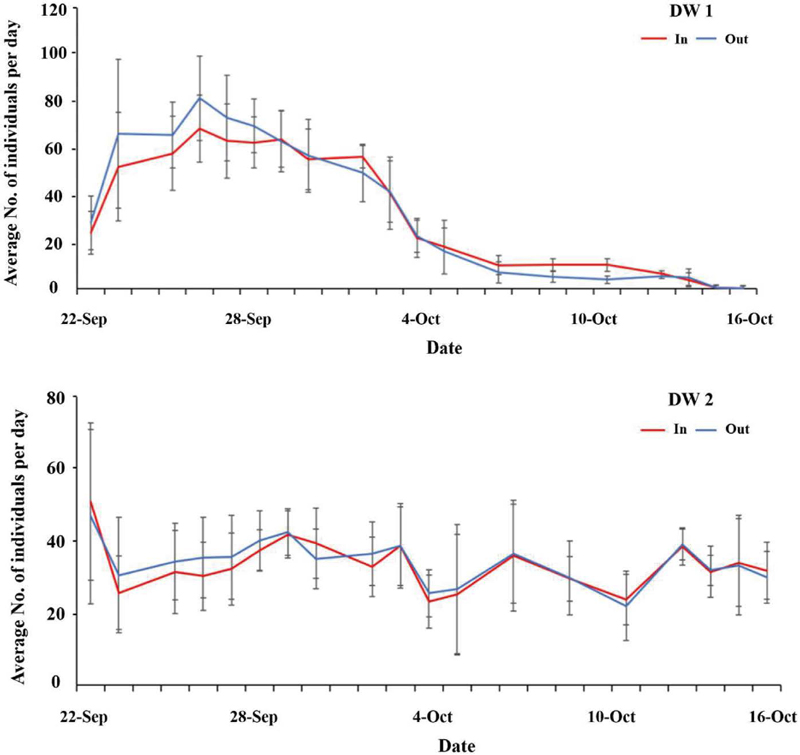
Activity of workers of V. velutina from two nests observed from September 22nd to October 16th, 2021. The number of workers entering and exiting the nest was recorded during each observation session, which lasted for 5 minutes. Error bars represent the standard error.
DW2 말벌집에서는 DW1과 다른 양상을 보였다. 관찰 기간 동안 활동 최성기는 조사 시작일인 9월 22일로 평균 이출입수 모두 약 50회가량으로 기록되며 1번 둥지보다 낮았다. 그러나 1번 둥지의 활동이 감소하는 10월 이후에도 일관적인 활동을 이어갔다. 이는 조사 종료 시점인 10월 16일까지 유지되었다 (Fig. 1).
DW1과 DW2의 기간에 따른 활동 패턴의 차이는 육안으로 확인하지 못하였으나, 여왕벌의 유무에 따른 것으로 판단된다. 두 봉군은 모두 같은 조건에서 관리되었으나, 활동수가 더 높았던 DW1은 10월에 급격한 활동 감소를 보였다. 말벌 여왕은 시간이 지남에 따라 날개 탈락 및 산란량 감소 등을 겪게 되며, 과정 중 일찍 탈락되기도 한다 (Martin et al., 2009). 말벌 봉군은 일벌에 의해 유지되기 때문에 일벌을 생산할 여왕벌을 잃은 봉군이 정상적인 활동을 보이지 못한 것으로 사료된다.
그러나 일간 활동 수준은 두 경우 모두 유사하였다. 비교적 이른 시간인 오전 6시부터 10~20회가량의 활동이 관찰되었으며 기온이 상승함에 따라 점차 증가하였다. 정오부터 15시까지 높은 활동 강도를 유지하다 16시부터 감소하는 패턴을 공유하였다. 일몰 이후인 19시에는 활동이 관찰되지 않았다 (Fig. 2).
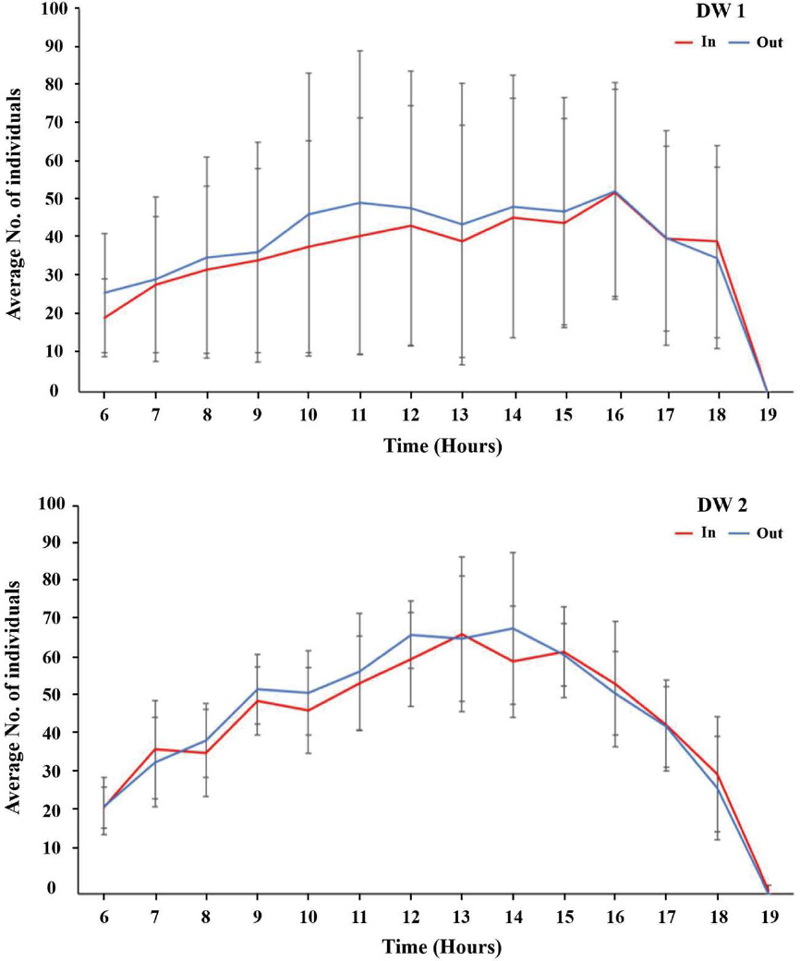
Number of individual workers of V. velutina entering (in) or leaving (out) the nests (DW1 and DW2) during the daytime during September 22nd to October 16th, 2021. The average number of worker entries and exits observed, with each observation conducted for 5 minutes. Error bars represent the standard error.
국내 등검은말벌의 일주활동 패턴은 일출, 일몰시간에 따라 상이한 부분은 있으나, 다른 지역과 유사하였다 (Perrard et al., 2009). 이는 말벌속 (Vespa)뿐만 아닌 유충에게 동물성 단백질을 급여하는 땅벌속 (Vespula)에서도 보이는 공통적인 패턴이다 (Edwards, 1980). 이른 아침부터 높은 활동 수준을 보이는 이유로 Perrard et al. (2009)은 밤 사이 유충이 소화를 마치고 새로운 먹이를 필요로 하고, 수분의 경우 아침 이슬의 형태로 수집하는 것이 가장 쉽기 때문일 것이라고 언급하였다.
2. 봉군 내부 온도
9월 27일부터 10월 16일까지의 평균 외부온도는 18.9±4.0 (SD)℃로 기록되었으나, 1번 둥지와 2번 둥지의 내부 온도는 23.7±4.4, 25.8±3.9℃로 외부 기온과 비교해 각각 4.8, 6.9℃씩 높았다. 그러나 기온이 급격히 하강함에 따라 외부 기온과 점차 유사해졌다. 조사 종료 시점인 11월 7일 이전까지 평균 외부 기온은 9.8±4.9℃였으며, 1번, 2번 둥지의 내부 기온은 13.1±6.3, 11.8±6.0℃로 3.4, 2.0℃ 차이로 감소하였다 (Fig. 3).
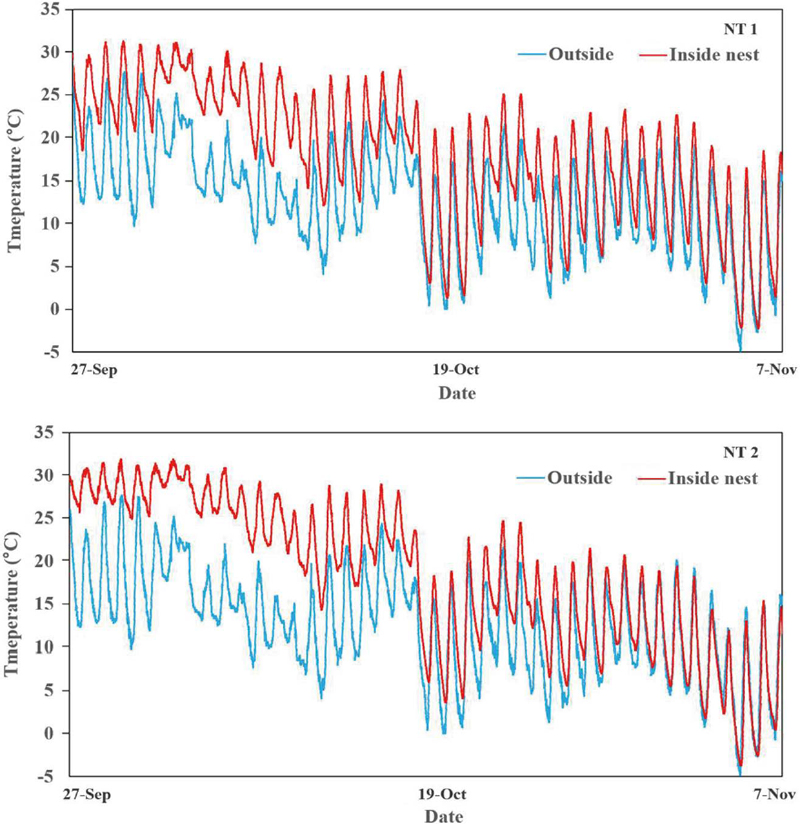
Temperature inside nest (solid line) and outside (dotted line) between September 27th to November 7th, 2022. The outside temperature data that used in both graphs are the same.
내부 온도는 야외와 달리 항상성을 유지하였다. 말벌을 비롯한 사회성 벌목 곤충들은 날갯짓을 통해 내부를 환기 및 습도를 유지시키며 (Klingner et al., 2005; Yi and Jung, 2010), 이로부터 발생하는 열을 통해 둥지 내부의 온도를 유지한다 (Martin, 1990; Stabentheiner, 2002). 그러나 10월 중순 이후로는 봉군 내 온도 조절 기능을 상실한 것으로 관찰되었다. 해당 시기는 생식세대를 생산하는 시기로 봉군 내 생식세대의 비율이 일벌을 추월하기 때문에 적극적인 온도 조절 활동이 감소한다. 봉군 내 온도 조절은 일벌에 의한 유충 양육의 목적이 크기 때문에 (Jones and Oldroyd, 2006; Feás Sanchez and Charles, 2019) 감소하는 것으로 추측된다.
양봉꿀벌 (Apis mellifera) 봉군의 내부 온도는 약 35℃로 보고되었으며 (Yi and Jung, 2010) 재래꿀벌 (A. cerana)도 이와 유사한 것으로 알려졌다 (Lee et al., 2020). 해당 온도는 유충들이 정상적으로 발육할 수 있는 온도로 (Groh et al., 2004; Tautz et al., 2008) 너무 높거나 낮아지면 일벌들에 의해 조절된다 (Tautz, 2008; Lee et al., 2020). 털보말벌 (V. similima), 좀말벌 (V. analis) 등의 정상적인 봉군 내부 온도는 28~30℃로 알려졌다 (Martin, 1990). 이는 꿀벌보다 다소 낮은 환경이며, 호박벌과 유사한 정도이다 (Yoon et al., 2010). 본 연구에서 기록된 등검은말벌 봉군 내부 온도가 이보다 낮은 것은 서술한 대로 집단 내 생식세대의 비율이 증가했기 때문일 것으로 사료된다.
3. 생식세대 발생
등검은말벌의 육안 관찰 시 더듬이가 짧고, 꽁무니가 날카로운 개체를 암컷으로 동정하였고, 무게를 측정하여 570 mg 이상인 암컷을 여왕벌로 판단하였다 (Fig. 4). 더듬이가 길고 생식기로 인해 꽁무니가 뭉툭한 개체를 수벌로 동정하였다. 조사기간 동안 3개의 둥지에서 평균적으로 일벌 231.3±15.4, 수벌 489.7±89.4, 여왕벌 102.7±42.9마리가 우화하였다. 조사 시작일부터 10월 초까지 하루에 약 15~20 마리 내외의 일벌이 우화하였다 (Table 2). 그러나 10월 16일을 기점으로 발생수가 급감하였다 (Fig. 5).
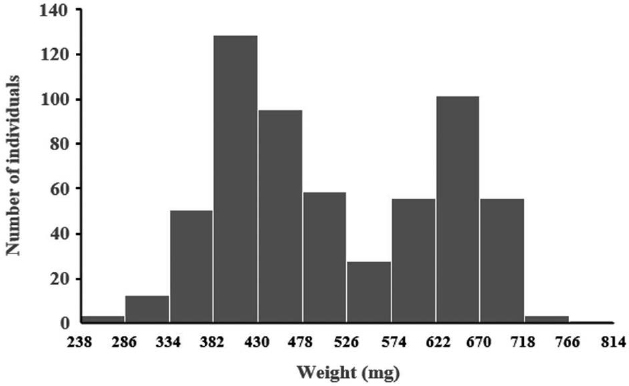
Frequency distribution of V. velutina adult female (worker+queen) relative to the fresh body weight. Average weight of worker was 407.1±56.9 (n=366) and that of queen was 621.6±14.9 mg (n=222).

Numbers of individual of each caste; queen, drone and worker emerged from each nest during September 25th to November 4th, 2022. Queens were designated as the individual weighing over 570 mg based on Fig. 4

Seasonal occurrence of V. velutina in autumn (September 25th to November 4th, 2022) (n=3). Nests were managed under laboratory condition at 25℃. Error bars represent standard error.
수벌의 경우 조사 시작일인 9월 25일 당일부터 평균 약 10마리 이상의 수벌이 우화한 것으로 보아 그 이전부터 발생이 시작된 것으로 사료된다. 둥지마다 차이는 있었으나 10월 초까지 하루 평균 약 15마리 내외의 발생을 보이다 10월 중순에 하루 평균 30마리 이상이 우화하며 발생 최성기를 기록하였다 (Fig. 5).
여왕벌의 경우 수벌과 비교해 약 1/5의 발생을 보였으며, 유사한 시기에 최대치를 기록하였다. 여왕벌과 수벌 모두 최성기를 기록한 이후 10월 말까지 지속적으로 감소하였다. 11월 3일 수벌 한 마리가 우화한 이후 더 이상 발생이 관찰되지 않아 조사를 종료하였다 (Fig. 5).
V. similima와 V. affinis의 수벌은 우화 후 둥지 내에서 약 8~11일 사이의 시간을 보내며 성적 성숙을 이룬 후 외부 활동을 시작한다고 보고되었다 (Martin, 1991, 1993). 등검은말벌의 경우 정소 (Testes) 성숙에 약 10일의 시간이 소요되며 이후부터 저정낭 (Seminal vesicle)에 정자가 주입된다. 이에 따라 10일 이전에는 짝짓기에 의한 수정이 불가능하다고 알려졌다 (Poidatz et al., 2018). 시간에 따른 생식기관의 성숙은 말벌속 곤충뿐만 아니라 다른 벌목 곤충에게도 보이는 공통적인 특징이다 (Boomsma et al., 2005; Fiorillo et al., 2008). 이러한 수벌 방출 특성에 따라 실질적인 발생 시기는 관찰된 것보다 약 10일 뒤일 것으로 예상된다. 실내 (25℃)에서 관리하였으나, 야외에서 사육하는 둥지의 내부 온도를 측정한 결과 평균 24.8℃를 기록하여 유충 발육에 소요되는 시간은 유사할 것으로 판단된다.
4. 생식세대 일간 활동
일벌은 일출 전인 오전 4시에는 활동을 보이지 않다 일출 직후인 오전 7시부터 외역 활동이 관찰되었다 (17.4±3.9). 이후 13시까지 활동 수가 약 두 배까지 증가하였다 (30.7±4.9). 활동은 16시까지 유지되다 (30.4±2.5) 일몰 후인 19시 이후에는 관찰되지 않았다 (Fig. 6). 활동이 관찰되지 않는 일출 이전, 일몰 이후에도 둥지 내부에서는 지속적인 활동이 관측되었다. 이는 온도 유지, 환기 등의 이유로 추정된다.
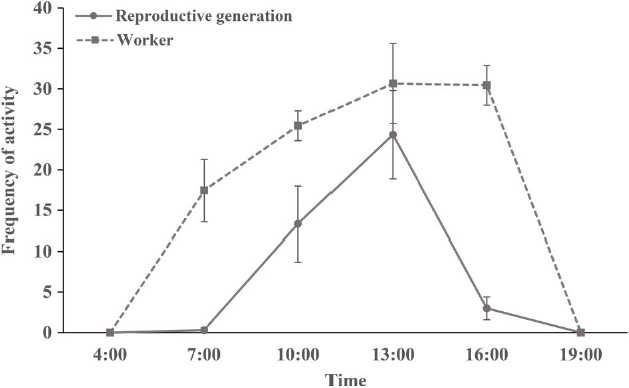
Number of reproductive generation and workers leaving the nest during October 25th to 27th, 2023. Each observation was conducted for 5 minutes. Error bars represent the standard error.
생식세대는 일출 직후인 7시에도 활동을 거의 보이지 않았다. 사육 온실 외부에서 관찰되는 수벌과 신여왕벌은 있었으나, 물리적 자극에도 움직임이 없고, 전날 일몰 후 (19시)와 동일한 위치인 점으로 보아 복귀하지 못하거나 온도 하강으로 인해 비행하지 못한 것으로 생각된다. 10시에 활동을 시작하여 13시에 활동 최성기를 기록하였다 (24.3±5.5). 그러나 일벌과 달리 16시에 활동이 급격히 감소하였으며 (3.0±1.4), 19시에는 마찬가지로 관찰되지 않았다. 생식세대의 활동은 일벌보다 늦게 시작해 일찍 마무리하는 것으로 관찰되었다 (Fig. 6).
상관분석 결과 생식세대 여왕벌 (0.89)과 수벌 (0.88)의 활동은 조도와 매우 강한 양의 상관관계를 보였다. 이외에도 여왕벌은 풍속 (0.65), 온도 (0.77), 수벌은 온도 (0.64)와 상관성을 보였다 (Fig. 7, Table 3). 13시 평균 온도는 약 21.3±1.0℃, 평균 조도는 33,788.9±8,125.9 lux로 기록되었다. 조사 동안 최대 풍속은 3 m/s로 비교적 약하였다.
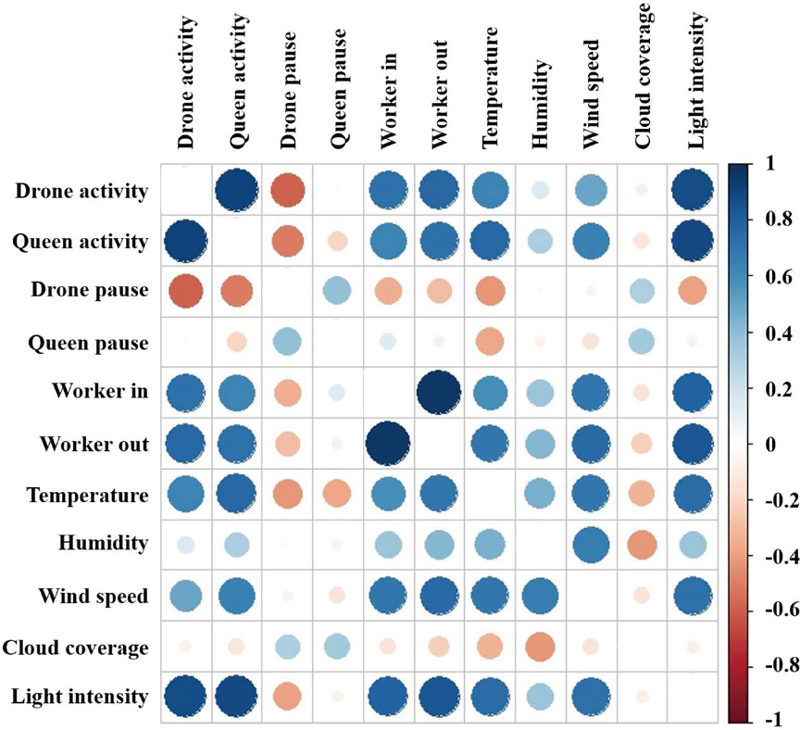
Correlation between activity and environment factors (Spearman’s rank correlation analysis). Blue indicates a positive correlation, red indicates a negative correlation. Large circles represent a high correlation.

Correlation coefficients (r) between activity levels of the reproductive generation and environmental variables with Spearman’s rank correlation analysis
생식세대의 일간 활동을 관찰한 말벌 사육 온실은 동쪽과 서쪽에 산을 끼고 있는 장소에 위치하였다. 이에 기록된 조도는 13시 (33,788.9±8,125.9)와 16시 (4,371.1±393.7 lux) 사이에 크게 감소하였다. 일벌의 경우 조도가 감소하기 시작하나 기온은 유지되는 13시 (21.3℃)에서 16시 (17.1℃) 사이에도 활발한 활동을 보인 반면, 생식세대의 활동은 크게 감소하였다. 조도뿐만 아니라 기온과도 양의 상관관계를 보였으나, 광량에 더 큰 영향을 받는 것으로 판단된다. 이는 주행성 곤충에서 보이는 행동 양상으로, 사회성 벌목 곤충인 호박벌은 높은 광량 조건에서 더 잦은 짝짓기 시도를 보였으며 (Yoon et al., 2005), 등검은말벌의 수벌은 광량이 최대가 되는 정오에 여왕벌에 강하게 유인되었다 (Wen et al., 2017). 생식세대의 활동은 풍속과 양의 상관관계를 보였다. 그러나 관찰 당시 최대 풍속은 3 m/s로 강하지 않았다. 말벌은 짝짓기 과정에서 페로몬을 활용하여 멀리 떨어진 상대를 감지한다 (Spiewok et al., 2006; Wen et al., 2017; Cappa et al., 2019). 페로몬 확산에 가장 큰 영향을 미치는 요인은 바람으로, 바람의 세기에 따라 페로몬을 인식할 수 있는 범위가 변하는 것으로 보고되었다 (Kanamura, 1976).
적 요
등검은말벌의 가을철 봉군 내부 온도는 평균 약 25℃ 내외로 외부 기온과 비교해 5℃가량 높게 유지되었다. 그러나 10월 중순 이후 생식세대 여왕벌과 수벌 생산이 끝나는 시점에서부터 봉구 내부 온도는 외기 온도와 비슷한 양상을 보였다. 생식세대 여왕벌과 수벌은 9월 중순~11월 초까지 활동하는 것으로 관찰되었으며, 발생 최성기는 10월 중순으로 확인되었다. 생식세대의 일간 활동은 10시부터 본격적으로 시작되며 13시에 활동 최성기를 기록하고, 비교적 이른 시간인 16시에 마무리되었다. 활동은 조도, 온도, 풍속과 양의 상관관계를 보였다.
Acknowledgments
본 연구는 한국연구재단 중점연구소 지원사업 (NRF-2018R1A6A1A03024862)과 농촌진흥청 연구과제인 ‘기후변화 요인별 꿀벌 비적응 시 발생하는 이상 요인 탐색 (PJ01476102)’의 지원으로 수행되었습니다.
References
- Abrol, D. P. 1994. Ecology, behaviour and management of social wasp, Vespa velutina Smith (Hymenoptera: Vespidae), attacking honeybee colonies. J. Apic. 9(1): 5-10.
-
Boomsma, J. J., B. Baer and J. Heinze. 2005. The evolution of male traits in social insects. Annu. Rev. Entomol. 50: 395-420.
[https://doi.org/10.1146/annurev.ento.50.071803.130416]

-
Cappa, F., A. Cini, I. Pepiciello, I. Petrocelli, A. F. Inghilesi, G. Anfora and R. Cervo. 2019. Female volatiles as sex attractants in the invasive population of Vespa velutina nigrithorax. J. Insect Physiol. 119: 103952.
[https://doi.org/10.1016/j.jinsphys.2019.103952]

-
Cheng, Y. N., P. Wen, K. Tan and E. Darrouzet. 2022. Designing a sex pheromone blend for attracting the yellow-legged hornet (Vespa velutina), a pest in its native and invasive ranges worldwide. Entomol. Gen. hal-03562571, version 1.
[https://doi.org/10.1127/entomologia/2022/1395]

-
Choi, M. B., S. J. Martin and J. W. Lee. 2012. Distribution, spread, and impact of the invasive hornet Vespa velutina in South Korea. J. Asia-Pac. Entomol. 15(3): 473-477.
[https://doi.org/10.1016/j.aspen.2011.11.004]

-
Cini, A., F. Cappa, I. Petrocelli, I. Pepiciello, L. Bortolotti and R. Cervo. 2018. Competition between the native and the introduced hornets Vespa crabro and Vespa velutina: a comparison of potentially relevant life-history traits. Ecol. Entomol. 43(3): 351-362.
[https://doi.org/10.1111/een.12507]

-
Crespo, N., J. Louzada, L. S. Fernandes, P. B. Tavares and J. Aranha. 2022. Microscopic Identification of Anatomical Elements and Chemical Analysis of Secondary Nests of Vespa velutina nigrithorax du Buyson. Insects 13(6): 537.
[https://doi.org/10.3390/insects13060537]

- Edwards, R. 1980. Social wasps, their biology and control. Rentokil Ltd., Felcourt, East Grinstead, Sussex RH19 2JY, UK.
-
Feás Sanchez, X. 2021. Human fatalities caused by hornet, wasp and bee stings in Spain: epidemiology at state and substate level from 1999 to 2018. Biology 10(2): 73.
[https://doi.org/10.3390/biology10020073]

-
Feás Sanchez, X. and R. J. Charles. 2019. Notes on the nest architecture and colony composition in winter of the yellow-legged Asian hornet, Vespa velutina Lepeletier 1836 (Hym.: Vespidae), in its introduced habitat in Galicia (NW Spain). Insects 10(8): 237.
[https://doi.org/10.3390/insects10080237]

-
Fiorillo, B. S., J. Lino-Neto and S. N. Báo. 2008. Structural and ultrastructural characterization of male reproductive tracts and spermatozoa in fig wasps of the genus Pegoscapus (Hymenoptera, Chalcidoidea). Micron. 39(8): 1271-1280.
[https://doi.org/10.1016/j.micron.2008.03.005]

-
Groh, C., J. Tautz and W. Rossler. 2004. Synaptic organization in the adult honeybee brain is influenced by brood temperature control during pupal development. Proc. Natl. Acad. Sci. USA. 101: 4268-4273.
[https://doi.org/10.1073/pnas.0400773101]

-
Jeong, S. M., C. Y. Lee, D. W. Kim and C. Jung. 2016. Questionnaire study on the overwintering success and pest management of honeybee damage assessment of Vespa hornets in Korea. Korean J. Apic. 31(3): 201-210.
[https://doi.org/10.17519/apiculture.2016.09.31.3.201]

-
Jones, J. C. and B. P. Oldroyd. 2006. Nest thermoregulation in social insects. Adv. Insect Physiol. 33: 153-191.
[https://doi.org/10.1016/S0065-2806(06)33003-2]

- Jung, C. 2012. Spatial expansion of an invasive hornet, Vespa velutina nigrithorax Buysson (Hymenoptera: Vespidae) in Korea. Korean J. Apic. 27(2): 87-93.
-
Jung, C., C. Y. Kim, J. M. Park, M. Sagong, K. R. Hong, J. Y. Jeon and J. K. Yoo. 2014. Species Composition and Seasonal Pattern of Vespa Hornets (Hymenoptera: Vespidae) in Youngju Residential Area, Gyoungbuk. Korean J. Apic. 29(4): 319-325.
[https://doi.org/10.17519/apiculture.2014.11.29.4.319]

- Jung, C., D. Kim, H. S. Lee and H. Baek. 2008. Some biological characteristics of a new honeybee pest, Vespa velutina nigrithorax Buysson 1905 (Hymenoptera: Vespidae). Korean J. Apic. 24: 61-65.
-
Kanamura, K. 1976. The effect of wind velocity on the diffusion of Spodoptera litura (F.) sex pheromone. Appl. Entomol. Zool. 11(4): 312.
[https://doi.org/10.1303/aez.11.312]

-
Klingner, R., K. Richter, E. Schmolz and B. Keller. 2005. The role of moisture in the nest thermoregulation of social wasps. Naturwissenschaften 92: 427-430.
[https://doi.org/10.1007/s00114-005-0012-y]

-
Kim, J. K., M. B. Choi and T. Y. Moon. 2006. Occurrence of Vespa velutina Lepeletier from Korea, and a revised key for Korean Vespa species (Hymenoptera: Vespidae). Int. J. Entomol. Res. 36(2): 112-115.
[https://doi.org/10.1111/j.1748-5967.2006.00018.x]

-
Kim, M. J., S. Bak and C. Jung. 2023. Modeling abundance and risk impact of Vespa velutina nigrithorax (Hymenoptera: Vespidae) in Korea: application of a species abundance model. Sci. Rep. 13(1): 13616.
[https://doi.org/10.1038/s41598-023-40016-9]

-
Lee, C. J., Y. H. Hong, M. L. Lee, C. H. Ryu and S. I. Kim. 2020. Comparison on Temperature, Humidity and Weight Changes among Different Types of Hive for the Asiatic Honeybee (Apis cerana). J. Apic. 35(1): 9-19.
[https://doi.org/10.17519/apiculture.2020.04.35.1.9]

-
Martin, S. J. 1990. Nest thermoregulation in Vespa simillima, V. tropica and V. analis. Ecol. Entomol. 15(3): 301-310.
[https://doi.org/10.1111/j.1365-2311.1990.tb00812.x]

- Martin, S. J. 1991. A simulation model for colony development of the hornet Vespa simillima (Hymenoptera, Vespidae). Jpn. J. Entomol. 59 (1): 105-124.
-
Martin, S. J. 1993. Weight changes in adult hornets, Vespa affinis (Hymenoptera: Vespidae). Insectes Soc. 40: 363-368.
[https://doi.org/10.1007/BF01253899]

-
Martin, S. J., J. I. Takahashi and S. I. Katada. 2009. Queen condition, mating frequency, queen loss, and levels of worker reproduction in the hornets Vespa affinis and V. simillima. Ecol. Entomol. 34(1): 43-49.
[https://doi.org/10.1111/j.1365-2311.2008.01040.x]

-
Matsuura, M. and S. Yamane. 1990. Biology of the Vespine Wasps. Springer-Verlag.
[https://doi.org/10.1007/978-3-642-75230-8]

-
Monceau, K., A. Tourat, M. Arca, O. Bonnard, G. Arnold and D. Thiéry. 2017. Daily and seasonal extranidal behaviour variations in the invasive yellow-legged hornet, Vespa velutina Lepeletier (Hymenoptera: Vespidae). J. Insect Behav. 30: 220-230.
[https://doi.org/10.1007/s10905-017-9607-3]

-
Monceau, K., O. Bonnard and D. Thiéry. 2013. Relationship between the age of Vespa velutina workers and their defensive behaviour established from colonies maintained in the laboratory. Insectes Soc. 60: 437-444.
[https://doi.org/10.1007/s00040-013-0308-4]

-
Monceau, K., O. Bonnard and D. Thiéry. 2014. Vespa velutina: a new invasive predator of honeybees in Europe. J. Pest. Sci. 87(1): 1-16.
[https://doi.org/10.1007/s10340-013-0537-3]

-
O’Donnell, S. 1998. Reproductive caste determination in eusocial wasps (Hymenoptera: Vespidae). Annu. Rev. Entomol. 43(1): 323-346.
[https://doi.org/10.1146/annurev.ento.43.1.323]

-
Perrard, A., J. Haxaire, A. Rortais and C. Villemant. 2009. Observations on the colony activity of the Asian hornet Vespa velutina Lepeletier 1836 (Hymenoptera: Vespidae: Vespinae) in France. Ann. Soc. Entomol. Fr. 45(1): 119-127.
[https://doi.org/10.1080/00379271.2009.10697595]

-
Poidatz, J., C. Bressac, O. Bonnard and D. Thiéry. 2018. Delayed sexual maturity in males of Vespa velutina. Insect Sci. 25(4): 679-689
[https://doi.org/10.1111/1744-7917.12452]

-
Rome, Q., A. Perrard, F. Muller, C. Fontaine, A. Quilès, D. Zuccon and C. Villemant. 2021. Not just honeybees: predatory habits of Vespa velutina (Hymenoptera: Vespidae) in France. Ann. Soc. Entomol. Fr. (NS). 57(1): 1-11.
[https://doi.org/10.1080/00379271.2020.1867005]

- Rortais, A., C. Villemant, O. Gargominy, Q. Rome, J. Haxaire, A. Papachristoforou and G. Arnold. 2010. A new enemy of honeybees in Europe: the Asian hornet Vespa velutina. p. 11. in Atlas of biodiversity risks - from Europe to the globe, from stories to maps, ed by Settele, J. Pensoft, Sofia, p. 11.
-
Roy, H. E., D. B. Roy and A. Roques. 2011. Inventory of terrestrial alien arthropod predators and parasites established in Europe. BioControl. 56: 477-504.
[https://doi.org/10.1007/s10526-011-9355-9]

-
Spiewok, S., E. Schmolz and J. Ruther. 2006. Mating system of the European hornet Vespa crabro: male seeking strategies and evidence for the involvement of a sex pheromone. J. Chem. Ecol. 32: 2777-2788.
[https://doi.org/10.1007/s10886-006-9162-4]

-
Stabentheiner, A., H. Kovac and S. Schmaranzer. 2002. Honeybee nestmate recognition: the thermal behaviour of guards and their examinees. J. Exp. Biol. 205(17): 2637-2642.
[https://doi.org/10.1242/jeb.205.17.2637]

-
Takahashi, J. I., J. Nakamura, S. I. Akimoto and E. Hasegawa. 2004. Kin structure and colony male reproduction in the hornet Vespa crabro (Hymenoptera: Vespidae). J. Ethol. 22: 43-47.
[https://doi.org/10.1007/s10164-003-0105-z]

-
Takahashi, J. I., S. I. Akimoto, E. Hasegawa and J. Nakamura. 2002. Queen mating frequencies and genetic relatedness between workers in the hornet Vespa ducalis (Hymenoptera: Vespidae). Appl. Entomol. Zool. 37(3): 481-486.
[https://doi.org/10.1303/aez.2002.481]

-
Takahashi, J. I., Y. Inomata and S. J. Martin. 2007. Mating structure and male production in Vespa analis and Vespa simillima (Hymenoptera: Vespidae). Entomol. Sci. 10(3): 223-229.
[https://doi.org/10.1111/j.1479-8298.2007.00217.x]

-
Takeuchi, T., R. Takahashi, T. Kiyoshi, M. Nakamura, Y. N. Minoshima and J. Takahashi. 2017. The origin and genetic diversity of the yellow-legged hornet, Vespa velutina introduced in Japan. Insectes Soc. 64: 313-320.
[https://doi.org/10.1007/s00040-017-0545-z]

-
Tautz, J., H. R. Heilmann and D. Sandeman. 2008. The buzz about bees: biology of a superorganism (Vol. 1007, pp. 978-3). Berlin: Springer.
[https://doi.org/10.1007/978-3-540-78729-7]

- Ueno, T. 2014. Establishment of the invasive hornet Vespa velutina (Hymenoptera: Vespidae) in Japan. Int. Trans. Chem. Environ. Biol. Sci. 2(4): 220-222.
-
Van Itterbeeck, J., Y. Feng, M. Zhao, C. Wang, K. Tan, T. Saga, K. Nonaka and C. Jung. 2021. Rearing techniques for hornets with emphasis on Vespa velutina (Hymenoptera: Vespidae): A review. J. Asia-Pac. Entomol. 24(2): 103-117.
[https://doi.org/10.1016/j.aspen.2021.03.009]

-
Villemant, C. 2008. Apis cerana se défend contre Vespa velutina: observations dans le massif forestier du Bi Doup, Vietnam (Hym.). Bull. Soc. Entomol. Fr. 113(3): 312.
[https://doi.org/10.3406/bsef.2008.2116]

-
Wen, P., Y. N. Cheng, S. H. Dong, Z. W. Wang, K. Tan and J. C. Nieh. 2017. The sex pheromone of a globally invasive honey bee predator, the Asian eusocial hornet, Vespa velu-tina. Sci. Rep. 7(1): 12956.
[https://doi.org/10.1038/s41598-017-13509-7]

- Yi, H. B. and C. Jung. 2010. European Honeybee (Apis mellifera L.) in Late Summer in Temperate Region. J. Apic. 25 (1): 1-7.
- Yoon, H. J., H, S. Sim, Y. S. Kim, S. E. Kim and S. B. Lee. 2005. Light Source, Temperature and Age Favorable for Mating of the Bumblebee, Bombus ignitus and B. terrestris. Korean J. Apic. 20(1): 59-66.
- Yoon, H. J., K. Y. Lee, I. G. Park and M. A. Kim. 2010. Temperature and Humidity Favorable for Colony Development of Korean Native Bumblebee Bombus hypocrita sapporoensis. Korean J. Apic. 25(2): 83-89.